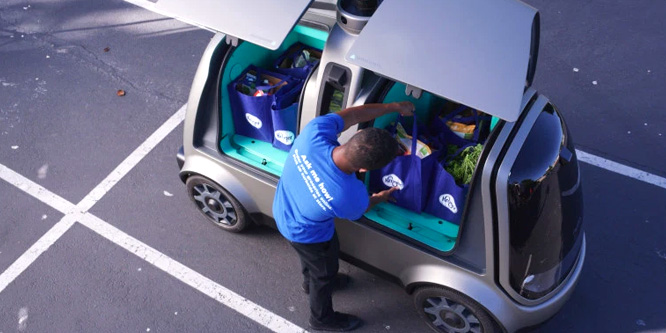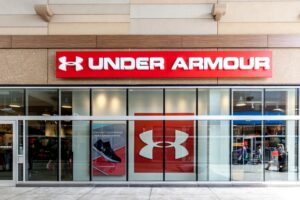
Photo: Nuro/Kroger
September 18, 2019
Retailers approach tech’s cutting edge with caution
Some of the most headline-grabbing retail technology is just the kind of stuff that retailers are hesitating to adopt, according to a new survey.
Robots, drones, beacons and facial recognition have thus far been adopted by fewer than 10 percent of retailers, according to a Total Retail report. This is despite other forms of retail technology, such as inventory management and order management systems, being adopted by 69 percent. It might be the case for the foreseeable future as well; while nearly three-fourths of those polled plan to increase tech spending over the next year, less than 20 percent plan to invest in the four cutting-edge technologies.
While few retailers appear to be adopting these hotly discussed technologies, some big names have piloted them. None of these pilots have come without criticism over questions of usefulness, privacy and safety depending on the technology.
At the beginning of the year Ahold Delhaize-owned Giant Foods and Stop & Shop announced the roll-out of a googly-eyed customer-facing robotic assistant named Marty, used to identify spills with an eye towards eventually managing inventory. In the spring, Walmart announced it would be rolling out floor-scrubbing robots to 1,500 locations.
Drones, both aerial and land-based, have been piloted as potential solutions to last-mile delivery difficulties with small vendors and names as big as Google, Amazon.com and UPS getting in on the act.
Beacons have come into use by, for instance, Target, which enables wayfinding via app based around Bluetooth beacons built into its LED lighting.
Facial recognition has been perhaps the most controversial of the cutting-edge solutions being piloted. A smart cooler pilot by Walgreens raised the concerns of privacy advocates over data collection.
While some uses remain questionable, customers seem more willing to avail themselves of in-store technology than ever before with the right use case and demonstrable value. Recent National Retail Federation numbers show 66 percent of consumers believe in-store technology has improved their shopping experiences.
- Retail Technology: All Talk, No Implementation – JD Supra
- NRF: Roving robots report for work at all Giant Foods stores – RetailWire
- Will Walmart clean up with its robotic workforce? – RetailWire
- Target guides customers through the aisles with beacons – RetailWire
- NRF study says customers dig retail tech – RetailWire
- Walgreens tests tech that sort of recognizes you in-store – RetailWire
Discussion Questions
DISCUSSION QUESTIONS: Are retailers wise to be cautious about investing in cutting-edge technologies (e.g., robots, drones, beacons and facial recognition)? At what point, if ever, will said technologies be considered tried-and-true?
Poll
BrainTrust
Georganne Bender
Principal, KIZER & BENDER Speaking
Harley Feldman
Co-Founder and CMO, Seeonic, Inc.
Recent Discussions







Retailers are right to be cautious. There’s no point in using technology for the sake of it, it has to do something to tangibly help the business. Too many technologies are searching for a purpose rather than solving issues.
Right on Neil. When evaluating some of these “innovative” technologies, retailers should be cautious. Just because you can, doesn’t mean you should!
New technology is always exciting and generally achieves much buzz in the media. However retailers are wise to pick and choose what they should invest in and, most importantly, roll out in-store because not everyone responds the same way. Some customers see technology as interfering in their personal life, and that can cause many problems. The most successful technology thus far has been the technology behind the scenes that customers do not see or services that a customer can choose to use like an app or in-store kiosk. When we provide services like facial recognition, that takes technology to a different level and indeed one can understand some customers’ apprehension.
In time some customers will become more comfortable while others will remain stubborn. We have had E-Z Pass for more than 30 years and there is still a percentage of drivers who refuse to get it for fear the government will be tracking them. Technology always moves faster than what the public can accept but, in time, many of these technology services will become standard in our everyday life. It will just take a lot longer to get there.
Yes, retailers are wise to be cautious about investing in cutting edge technology. However, at the same time, retailers also need to stay apprised of the latest technology advancements and carefully consider specifically how they might be leveraged to produce better store experiences for shoppers and improved business results for the retailer. Like all technology advancements, not all of them prove to be effective or turn out the way that was expected. Whether a technology ever becomes “tried-and-true” will ultimately be proven over time – adoption rates and the level of competition in providing these solutions are good indicators.
Retailers have a host of opportunities to improve the shopping experience, and they’re going to prioritize the most impactful ones first. There will always be bright shiny objects (robots that greet you! Mirrors that talk!) but technologies that drive sales and improve profits will always be adopted first.
If it is customer-facing and adds true convenience to make the experience better, most anyone would spend on it. The reality has never kept up with many of the shiny objects at the Big Show. If you have to explain it to every employee and each customer and teach them how to use it to get use, it is a nice-to-have, not a must-have. Put your money in training the people in your store who have the greatest power to increase conversions and build basket.
There is too much hype about new technologies. A retailer has only limited financial resources and needs to examine very carefully in which technologies to invest. Ninety percent of new retail technologies is simply gimmicks. The crucial challenge is to understand where the vital 10 percent lies.
Injecting cutting edge tech in most retail environments might be a good example of a scenario where the smart move is to be a fast second — or even a slow second.
Caution is the name of the game for the vast majority of retailers. There is a plethora of new technologies claiming to improve customer satisfaction, help revenue or save money – and the economy is good, so we are seeing a lot of experimentation. Our data shows a very high interest and adoption rate in technology such as AI/ML which enhances current solutions to allow for better visibility and decision making. There will be winners and also-rans with what is currently being pushed by tech companies but don’t forget that mobile (e.g. smartphones, tablets) is just over 10 years old and look how that has transformed the industry.
Yes, retailers should be cautious about adopting expensive new technologies, especially ones that are meant to thrill shoppers. Sure, customers will use technology when it’s convenient for them, but currently I think it’s pretty evident that customers just don’t care.
Robots that clean floors earn their keep, but do the rest of these technologies we’ve been talking about forever grow sales? Do they improve the overall store experience? Retailers would be better off using those dollars to hire the right people and train them to provide stellar customer service on the sales floor.
Many retailers today are reluctant to invest in new technology and sweat their current assets because they are concerned about the threat of online and/or protecting their profitability. The new technologies are still to be proven and most retailers do not like to be on the bleeding edge of technology. Frankly, they need to get their core technology up-to-date before they start to think they can take a run at some of the more advanced future technologies.
The larger retailers will always push the boundaries first. They will then either benefit from the advantages gained or write off the costs which smaller retailers can ill afford. Getting the basics right must always be the first priority. If they can’t get their inventory accurate or prices right then to move forward to robotics will only cause more distress and pain, and will not solve their issues. If a retailer is already at peak performance, then it is right to look for the next possible improvement and some of the new technologies undoubtedly will give them a competitive advantage. However, if they do not have the basics right then they should not rush down this route first.
Many cutting-edge technology offerings today bring with them shiny new object syndrome (the one mentioned by Cathy Hotka) and cannot deliver sufficient practical improvement. One robot to greet customers by the door, maybe. However fast, convenient payment systems, for one, have a bigger impact. Facial recognition where identification is required, maybe (yes, in airports). Systems that improve inventory accuracy can deliver more practical value than a drone.
Retail magic and merchandising are all about mastering the arts and sciences. Purpose-led technological investments only make sense when they are centered around solving a complex business challenge and driving outstanding customer experiences.
Integrating new technologies have big implications for and impacts on the organization, and it is very much a cultural shift as well as an executive sponsored strategy to leverage them the right way. This is why we recommend taking a crawl/walk/run approach to any retail transformation, so there are specific, measurable, achievable relevant and timely objectives. It’s critical for retailers and brands to stay true to their core purpose and enable these technologies to add significant if not incremental value for the customer experience.
Retailers should be evaluating and testing technologies that they believe will make them more competitive and are useful to their customers. The cautiousness should come from the costs incurred to implement, whether customers accept the technology and the value created. The technologies need to be tested on these attributes whether in the store or wherever they will affect customer service. They will be tried-and-true when their value is determined and their costs justified.
While many of these new innovations (beacons, drones, facial recognition, etc.) are interesting and have garnered a lot of media attention, they are not all accepted by consumers and many are hard to justify from an ROI perspective.
Some of the other cutting-edge technology that is not as visible may have greater benefits for retailers, such as artificial intelligence and machine learning to improve planning decisions and offer personalized recommendations.
If and when technologies demonstrate tangible and acceptable ROI, companies adopt. This article could be extended to include technologies that have had fits and starts for decades. I know of grocers that have tried shopping cart-mounted tablets since before people even had smartphones. And when will RFID finally take hold at the item level in-store?
Press releases that indicate one retailer is investing in or testing X new technology are often followed by another retailer saying that they are too, or making similar statements about Y technology. In neither case is there a current need for the technology. The issue with leading edge technology is that it is far too often also bleeding edge.
I do think that all retailers must have their heads above the sand and be willing to challenge themselves in the adoption of new technologies – carefully. I think that the guidelines on what determines their adoption need to be how these tools will reach their customers’ hearts and add unexpected pleasures to the store experience, while creating a customer perception of ease, comfort and control. This is no time for a retailer to sit down and watch in this rapidly-moving technology-enhanced world.
When a retailer is debating technologies and are putting the customer first in their decision making process then yes, they should proceed. However I think most are putting the customer way down on the list when deciding how some of these new solutions will be used within the organization.
It’s all about sales and profits, not being first or being slick, in most retail cases.
Tech WILL revolutionize bricks retailing, but the total process will be S – L – O – W! However, I say THAT with caution. It reminds me of the guy telling his buddy that he has gone bankrupt, and his buddy wants to know how that happened. He said, at first, little by little, and then, ALL OF A SUDDEN! I expect widespread adoption of tech to be something like that, with the CPG/FMCG market last impacted.
However, adoption of technology for management of logistics will be first, since bricks retailers are largely oblivious to the shoppers, given their massive job of managing tens of thousands of items, scores of categories, and many hundreds of suppliers. This is why retailers largely leave shoppers to “do their own thing,” coming into the retailer’s “merchant warehouse,” aka supermarket, and getting whatever they want.
This has been a progressively super-successful business model for the past century, with shopper technology being only at the cutting edge in a few places – Amazon in the van! (Not at Whole Foods, yet.) However facial recognition will probably be first, since it is already so far advanced in a few places. Your iPhone RECOGNIZES you, and only occasionally asks you to verify by entering your own code.
There is no reason that image recognition of both shoppers and products will not ultimately dominate self-service retailing throughout the bricks world. Walk-in, take what you want, and you will be immediately notified of your growing checkout total, if you want to follow it.
Think it through and you will see how the dominant advantages of online and bricks will merge:
For bricks: 1.) immediacy; 2.) 360 experience.
For online: 1.) Algorithmic selling, beginning with the immediate offer of what you most likely want to buy RIGHT NOW! 2.) INFINITE long tail, that is, every possible option for what you are interested in.
Don’t let the future catch you totally unprepared. You might even profit from the cutting edge!
What is going on? PR in search of media hype. Whatever happened to retail merchants? Somewhere along the line, merchant tech insecurity has created a Jetsons-like frenzy replacing common sense.
Merchant tech insecurity … MTI. Love it!
I believe a cautious approach is best with these technologies. The use cases just aren’t that persuasive. These technologies will only be adopted when there is a hard savings return on investment (ROI). Hard savings ROI is literally head-count reduction and these technologies, to date, have not leaped over that threshold. Beacons are less intrusive and a lower investment so I believe they will be adopted first … facial recognition maybe never. Robots may be a close second for cleaning (a la Walmart), and pick, pack and ship in the DC.
We have a 60% failure rate in retail Kiosks. The issues are clear. 1) Kool the first usage – but how about the 12th time? 2) Is it bored kid proof? 3) The depreciation schedule for fixtures for most retailers is 5 years. Is the tech going to last that long? Neiman’s reported they were pulling out most of their “Smart Mirrors.” They were either broken, or no one was using them outside the beauty department.
I’ve always said that tech shouldn’t be used for tech’s sake. It needs to serve a purpose and to improve things for either the customer, the retailer or both. If it doesn’t then it will quickly fall by the wayside. Without a doubt order and inventory management are going to make more difference to most retailers than robots at this stage.
I think retailers should ensure they’re aware of the new technologies that are out there and what they can do because then they can make an informed decision about whether it works for their business. Not every retailer is the same and what makes sense for some won’t for others. They should also regularly reassess the developments though. Something that might not make sense now might in the future with a different application or cheaper price point.
Have to chime in on this thread. Of course retailers should proceed with caution. All business decisions should proceed with caution. The real question is whether retailers should proceed with caution on widespread distribution and adoption of the tech. Right now, most of these techs are POCs. Scaling the tech across thousands of stores will be the real test. It will also define what’s tried and true.
My perspective is that much of the issue here is that organisations very often evaluate these sort of initiatives in isolation of one another. Very often the business case is unlikely to stack up like this or there are huge obstacles in terms of connecting to the existing infrastructure to make it actually work efficiently (for example a store robot adds real value for on-shelf availability when it knows what stock is available in the back-room so it can send an instruction to store teams to replenish the shelf.)
This ability to connect systems — existing and new — is what I see time and time again as the biggest obstacle to these innovations being used.